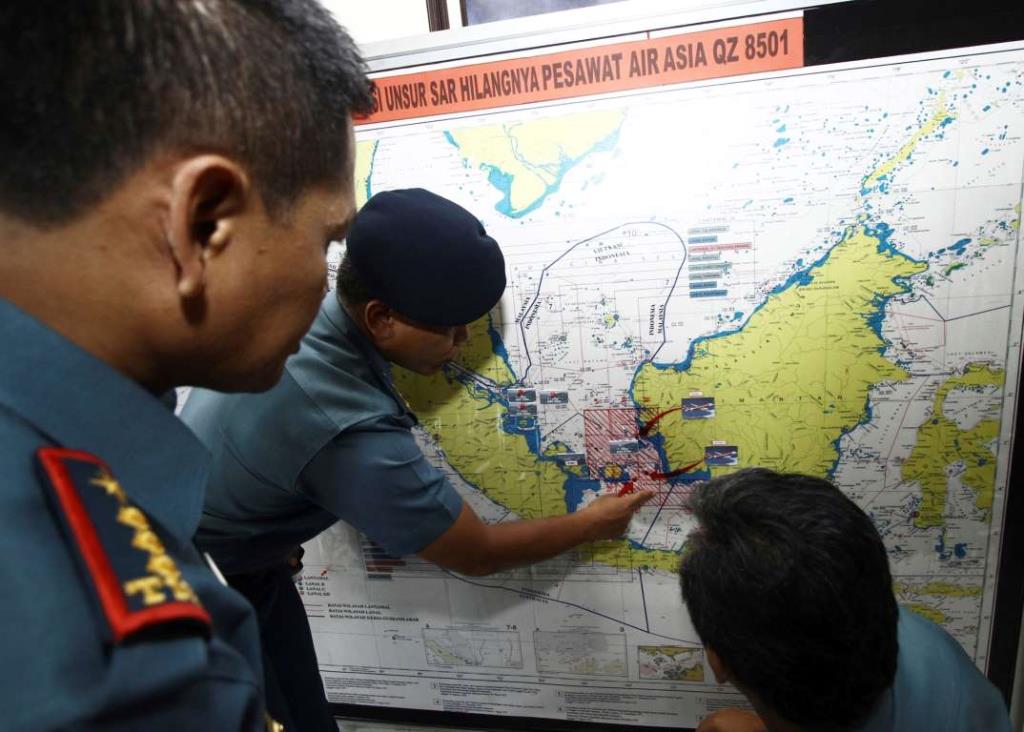December 31, 2014
PANGKALAN BUN/SURABAYA, Indonesia – A break in bad weather on Thursday raised hopes that divers would be able to investigate what is believed to be the sunken wreck of an AirAsia jet off Borneo and retrieve the plane's black box that should explain the cause of the crash.

December 31, 2014
PANGKALAN BUN/SURABAYA, Indonesia – A break in bad weather on Thursday raised hopes that divers would be able to investigate what is believed to be the sunken wreck of an AirAsia jet off Borneo and retrieve the plane's black box that should explain the cause of the crash.

Navy soldiers examine a map of Indonesia during search and rescue operations for a missing AirAsia plane at a navy base on Batam island, December 29, 2014.
The Airbus A320-200, carrying 162 people, fell from the sky while trying to climb above stormy weather early on Sunday, during a flight from the Indonesian city of Surabaya to Singapore. The pilots did not issue a distress signal.
So far, at least eight bodies have been recovered from waters near where sonar has detected a large, dark object on the ocean floor, lying just 30-50 metres (100-165 feet) deep. But so far rough seas have prevented divers from investigating it.
"They will try again this morning," said Siahala Alamsyah, a naval officer involved in the search. He said that on Wednesday night, bad weather had prevented a team of 47 Indonesian Navy divers from even flying out to warships at the crash site.
However, the skies over Pangkalan Bun air base near the site cleared on Thursday morning and the seas calmed, raising hopes that the search effort could be stepped up.
The plane's black box flight data and cockpit voice recorder should help solve the mystery of the crash. Investigators are working on a theory that it went into aerodynamic stall as the pilot climbed steeply to avoid a storm.
Bodies recovered from the Java Sea are being taken in numbered coffins to Surabaya, where relatives of the victims have gathered, for identification. Authorities have been collecting DNA from the relatives to help identify the bodies.
Some of the bodies recovered so far have been fully clothed, including a flight attendant still wearing her AirAsia uniform. That could indicate the Airbus was intact when it hit the water and also support the aerodynamic stall theory.
Most of the 162 people on board were Indonesians. No survivors have been found.
HUNT FOR "BLACK BOX"
Strong wind and waves hampered the search, and with visibility at less than a kilometre (half a mile), the air operation was called off on Wednesday afternoon.
Speaking on Wednesday evening, Fransiskus Bambang Soelistyo, the head of the search and rescue agency, said the weather was "challenging in the field, with waves up to 5 metres high, wind reaching 40 km per hour (and) heavy rain, especially in the search area."
Indonesian President Joko Widodo said his priority was retrieving the bodies.
Relatives, many of whom collapsed in grief when they saw the first grim television pictures confirming their fears on Tuesday, held prayers at a crisis centre at Surabaya airport.
"UNBELIEVABLY" STEEP CLIMB
The plane was travelling at 32,000 feet (9,753 metres) and had asked to fly at 38,000 feet to avoid bad weather. When air traffic controllers granted permission for a rise to 34,000 feet a few minutes later, they received no response.
A source close to the probe into what happened said radar data appeared to show that the aircraft made an "unbelievably" steep climb before it crashed, possibly pushing it beyond the Airbus A320's limits.
"So far, the numbers taken by the radar are unbelievably high. This rate of climb is very high, too high. It appears to be beyond the performance envelope of the aircraft," he said.
The source, who declined to be named, added that more information was needed to come to a firm conclusion.
Online discussion among pilots has centred on unconfirmed secondary radar data from Malaysia that suggested the aircraft was climbing at a speed of 353 knots, about 100 knots too slow, and that it might have stalled.
The Indonesian captain, a former air force fighter pilot, had 6,100 flying hours under his belt and the plane last underwent maintenance in mid-November, according to the airline, which is 49 percent owned by Malaysia-based budget carrier AirAsia.
Three airline disasters involving Malaysian-affiliated carriers in less than a year have dented confidence in the country's aviation industry and spooked travelers.
Malaysia Airlines Flight MH370 went missing in March on a trip from Kuala Lumpur to Beijing with 239 passengers and crew and has not been found. On July 17, the same airline's Flight MH17 was shot down over Ukraine, killing all 298 people on board.
On board Flight QZ8501 were 155 Indonesians, three South Koreans, and one person each from Singapore, Malaysia and Britain. The co-pilot was French.
The AirAsia group, including affiliates in Thailand, the Philippines and India, had not suffered a crash since its Malaysian budget operations began in 2002.
Courtesy: Reuters







































































































